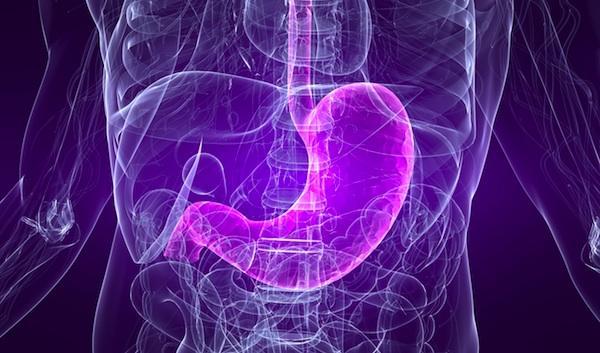Stomach: Facts, Functions & Diseases

After swallowing, food and drink make its way down the esophagus to the stomach. The stomach is the first stop in the digestive tract before food moves on to the small intestine.
Function
The stomach is a bean-shaped sack located behind the lower ribs. Once food hits the stomach, sphincters at the opening of the stomach and the exit into the small intestine close. The lining of the stomach then secretes hydrochloric acids and enzymes that break down the food so that it can continue on its journey through the digestive system, according to the Cleveland Clinic. As it secretes acid and enzymes, the stomach muscles contract in a process called peristalsis to mix the food with the acid and enzymes.
The acid also works to kill harmful microbes that may have made their way into the body along with food and drink. The acid could damage the stomach, so it secretes a sticky, neutralizing mucus that coats its walls and protects it from damage. The stomach also makes a substance that is necessary for the body to absorb vitamin B12, according to the Digestive Disease Center (DDC).
The stomach is the widest part of the digestive system. It not only digests food, it also stores it. According to the BBC, the stomach can hold a bit more than a quart (1 liter) of food at once. The design of the stomach allows a person to eat a large meal that can be digested slowly over time. It can take four to six hours or longer to digest a meal, according to the BBC. The higher the fat content of the food, the longer it takes for the food to digest.
Conditions and diseases
The stomach can have many different conditions and diseases that can cause pain, discomfort, digestion problems and even death.
One of the most common stomach problems is upset stomach or dyspepsia. “Dyspepsia is a term used to describe one or more symptoms, including a feeling of fullness during a meal, uncomfortable fullness after a meal, and burning or pain in the upper abdomen,” Dr. Lisa Ganjhu, clinical assistant professor of medicine and gastroenterologist at NYU Langone Medical Center, told Live Science.
Upper abdominal pain, indigestion and heartburn affects around 25 percent of the population each year, according to the DDC. Treatment of upset stomach usually depends on the cause. The cause can be as benign as food intolerance or gastroesophageal reflux disease (GERD), or as serious as an ulcer or cancer.
Get the world’s most fascinating discoveries delivered straight to your inbox.
GERD happens when acid contents in the stomach get refluxed up into the esophagus. Spicy foods, mint, chocolate, caffeine, alcohol or citrus foods increase inflammation or acidity in the stomach, which can trigger reflux. Foods that take longer to digest, like fatty foods, can make GERD symptoms worse. Stress and anxiety can also contribute to GERD, said Ganjhu.
Stomach ulcers are breaks in the lining of the stomach, caused by certain medications and too much acid in the stomach. These breaks are exposed to the acids in the stomach, causing pain. In most cases, ulcers can easily be treated with medication.
Stomach cancer is cancer that originates in the stomach. According to the U.S. National Library of Medicine (NLM), it mostly affects older people. Two-thirds of the people affected with stomach cancer are over age 65. In its advanced stages, some symptoms of stomach cancer are unexplained weight loss, vomiting, blood in the stool, jaundice or trouble swallowing. Around 10,720 people die from stomach cancer each year, according to the American Cancer Society.
Stomach flu isn’t a flu at all. It is a stomach virus. Flus affect the respiratory system, not the digestive tract. According the Mayo Clinic, some common symptoms are watery, usually non-bloody diarrhea, abdominal cramps, vomiting, nausea, muscle aches, headache and low-grade fever.
Promoting good stomach health
Ganjhu gives these tips for the best way to prevent digestive problems such as constipation and upset stomach:
- Eat small meals.
- Avoid all carbonated drinks.
- Eat a diet rich in fruits and vegetables and cut down on fatty foods.
- Quit smoking.
- Lose weight.
- After meals, take a walk or stay upright.
- Avoid bedtime snacks.
- Avoid irritating foods.
- Drink at least eight glasses of water or other non-caffeinated liquid per day.
- Use acid-blocking medications, if needed.
- Load up on fiber to bulk your stools. Eat at least 25 to 30 grams of fiber per day.
- Exercise 30 to 40 minutes, three to five times a week to help with total gastrointestinal (GI) health. Walking, running, weight training/resistance training all help.
- Eat probiotics to keep the microbiome healthy if you have GI issues.
- Go to the bathroom when you have the urge. Don't wait.
- If you are having hard stools try over-the-counter stool softeners or try 1 tablespoon of mineral oil, olive oil or flax seed oil.
Additional resources



